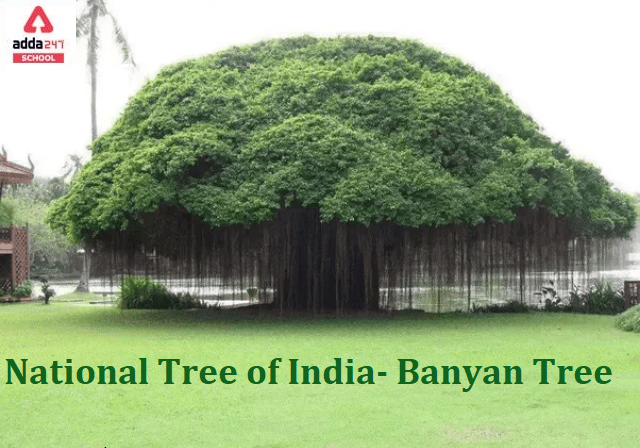National Tree of India is Banyan Tree
The Banyan tree, also known as the Indian fig tree is the national tree of India. The Indian government adopted the banyan tree as a national tree of India in the year 1950. The Banyan tree is home to distinct animals and birds that reflect India and its people of many races, faiths, and castes. Ficus bengalensis” is its scientific name, and it grows in a wide range of habitats. The tree is also known as “Kalpavriksha”, which translates to “wish-fulfilling tree.” Banyan tree is present everywhere in India, regardless of area or climate, which is one of the key reasons for choosing it as a national tree of India. The Banyan tree has several medical benefits and is connected with longevity. In Hindu philosophy, the banyan tree is regarded as a sacred tree. For centuries, people from the village have discussed incidents under the banyan tree, it was the main spot to discuss the village affairs. Because of its ever-expanding branches, the Banyan tree signifies finite existence. The country’s unity is signified by the tree’s massive structure and its deep roots.
National Tree
The concept of a “national tree” varies from country to country, as different nations designate certain trees as symbolic or representative of their culture, history, or values. For example:
- The United States: Oak Tree
- Canada: Maple Tree
- India: Banyan Tree
- Brazil: Pau Brasil
These trees often hold cultural or historical significance and may be featured in national emblems, folklore, and other forms of expression.
National Tree of India Name is Banyan Overview
| Kingdom | Plantae |
| Name | Banyan Tree |
| Family | Moraceae |
| Adopted in | 1950 |
| Genus | Ficus |
| Order | Urticales |
| Found in | Indian Subcontinent |
| Type | Figs |
| Dimensions | Height: 10-25 m; Spread: as far as 100 m |
| Division | Magnoliophyta |
| Class | Magnoliopsida |
| Found in | Native to Indian Subcontinent |
| Habitat | Terrestrial |
| Conservation Status | Not-threatened |
| Scientific Name | Ficus benghalensis |
Read More: Autotrophic Nutrition
Read More: Uses of Concave Mirror
The National Tree of India is Banyan Name and Scientific Name and Importance
Here we have given the significance of the Banyan tree which is the National Tree of India. Check out the importance of the Banyan Tree listed below:
- The largest Banyan tree is present in Kolkata, India. It also holds Guinness World Records for the largest banyan tree in the world.
- In Hindu mythology, our National Tree of India i.e. Banyan tree considered heavenly and divine. There is a verse in the Bhagavad Gita about the Banyan tree that says, “I am Banyan tree among trees.”
- The National Tree of India, the banyan tree is part of Indonesia’s national emblem. It is meant to represent Indonesia’s unity: a country with numerous forked roots.
- Banyan Tree also known as Ashwath Vriksha and provides perpetual life due to its noticeable increasing branches.
- Our National Tree of India, the Banyan tree is also called “Kalpavriksha” which means ‘wish-fulfilling divine tree’.
- Ta Prohm of Angkor Wat temple is known for the massive banyans that grow up, around, and through its walls.
Banyan Tree in Hindi
भारत का राष्ट्रीय वृक्ष
बरगद का पेड़, जिसे भारतीय अंजीर के पेड़ के रूप में भी जाना जाता है, भारत का राष्ट्रीय वृक्ष है। भारत सरकार ने वर्ष 1950 में बरगद के पेड़ को भारत के राष्ट्रीय वृक्ष के रूप में अपनाया। बरगद का पेड़ विशिष्ट जानवरों और पक्षियों का घर है जो भारत और कई जातियों, धर्मों और जातियों के लोगों को दर्शाते हैं। Ficus bengalensis” इसका वैज्ञानिक नाम है, और यह निवासों की एक विस्तृत श्रृंखला में बढ़ता है। पेड़ को “कल्पवृक्ष” के रूप में भी जाना जाता है, जिसका अनुवाद “इच्छा-पूर्ति करने वाला पेड़” होता है। बरगद का पेड़ भारत में हर जगह मौजूद है, चाहे वह किसी भी क्षेत्र का हो या जलवायु, जो इसे भारत के राष्ट्रीय वृक्ष के रूप में चुनने के प्रमुख कारणों में से एक है। बरगद के पेड़ के कई चिकित्सीय लाभ हैं और यह दीर्घायु से जुड़ा है। हिंदू दर्शन में, बरगद के पेड़ को एक पवित्र वृक्ष माना जाता है। सदियों से, लोग गांव से बरगद के पेड़ के नीचे की घटनाओं पर चर्चा की है, यह गांव के मामलों पर चर्चा करने का मुख्य स्थान था। इसकी लगातार बढ़ती शाखाओं के कारण, बरगद का पेड़ सीमित अस्तित्व का प्रतीक है। देश की एकता पेड़ की विशाल संरचना और इसकी गहराई से प्रकट होती है|
Indian National Tree Name in Hindi
भारत का राष्ट्रीय वृक्ष बरगद का नाम और वैज्ञानिक नाम और महत्व है
यहां हमने बरगद के पेड़ का महत्व दिया है जो भारत का राष्ट्रीय वृक्ष है। नीचे सूचीबद्ध बरगद के पेड़ के महत्व की जाँच करें:
भारत के कोलकाता में सबसे बड़ा बरगद का पेड़ मौजूद है। यह दुनिया के सबसे बड़े बरगद के पेड़ के लिए गिनीज वर्ल्ड रिकॉर्ड भी रखता है।
हिंदू पौराणिक कथाओं में, हमारे भारत के राष्ट्रीय वृक्ष यानि बरगद के पेड़ को स्वर्गीय और दिव्य माना जाता है। भगवद गीता में बरगद के पेड़ के बारे में एक श्लोक है जो कहता है, “मैं पेड़ों के बीच बरगद का पेड़ हूं।”
भारत का राष्ट्रीय वृक्ष, बरगद का पेड़ इंडोनेशिया के राष्ट्रीय प्रतीक का हिस्सा है। यह इंडोनेशिया की एकता का प्रतिनिधित्व करने के लिए है: कई कांटेदार जड़ों वाला देश।
बरगद के पेड़ को अश्वथ वृक्ष के रूप में भी जाना जाता है और इसकी ध्यान देने योग्य बढ़ती शाखाओं के कारण शाश्वत जीवन प्रदान करता है।
हमारे भारत के राष्ट्रीय वृक्ष, बरगद के पेड़ को “कल्पवृक्ष” भी कहा जाता है जिसका अर्थ है ‘इच्छा-पूर्ति करने वाला दिव्य वृक्ष’।
अंगकोर वाट मंदिर का ता प्रोहम बड़े पैमाने पर बरगदों के लिए जाना जाता है जो इसकी दीवारों के चारों ओर और चारों ओर बड़े होते हैं।
List of National Trees and Scientific Names
Here we have given the list of official and some unofficial list of Nation trees with their scientific names. Have a look at the list of National trees given below in the table:
| Country | Common name | Scientific name |
| Afghanistan | Mulberry (unofficial) | Morus nigra |
| Albania | Olive | Olea europaea |
| Antigua and Barbuda | Whitewood | Bucida buceras |
| Angola | Baobab | Adansonia digitata |
| Argentina | Ceibo | Erythrina crista-galli |
| Red Quebracho | Schinopsis balansae | |
| Australia | Golden Wattle | Acacia pycnantha |
| Bahamas | Lignum Vitae | Guaiacum sanctum |
| Bangladesh | Mango tree (Aam Gaachh) | Mangifera indica |
| Belarus | Oak (unofficial) | Quercus robur |
| Belize | Honduras Mahogany | Swietenia macrophylla |
| Bhutan | Bhutan Cypress | Cupressus cashmeriana |
| Brazil | Brazilwood | Caesalpinia echinata |
| Cambodia | Palmyra palm | Borassus flabellifer |
| Canada | Maple | Acer |
| Chile | Araucaria | Araucaria araucana |
| Colombia | Quindio wax palm | Ceroxylon quindiuense |
| Costa Rica | Guanacaste | Enterolobium cyclocarpum |
| Croatia | Pedunculate oak | Quercus robur |
| Cuba | Cuban royal palm | Roystonea regia |
| Cyprus | Golden oak | Quercus alnifolia |
| Czech Republic | Small-leaved Lime/Small-leaved Linden | Tilia cordata |
| Denmark | European beech | Fagus sylvatica |
| Pedunculate oak | Quercus robur | |
| Dominican Republic | West Indian Mahogany | Swietenia mahagoni |
| Ecuador | Cinchona pubescens | Cinchona pubescens |
| El Salvador | Maquilishuat | Tabebuia rosea |
| England | Royal Oak | Quercus robur |
| Estonia | Pedunculate Oak | Quercus robur |
| Finland | Silver Birch | Betula pendula |
| Germany | Oak | Quercus |
| Greece | Olive | Olea europaea |
| Guatemala | Ceiba | Ceiba pentandra |
| Haiti | Royal palm | Roystonea |
| India | Indian banyan | Ficus benghalensis |
| Indonesia | Teak | Tectona |
| Ireland | Sessile Oak | Quercus petraea |
| Iran | Mediterranean cypress | Cupressus sempervirens |
| Israel | Olive | Olea europaea |
| Italy | Strawberry tree | Arbutus unedo |
| Jamaica | Blue Mahoe | Talipariti elatum |
| Japan | Japanese cherry blossom | Prunus serrulata |
| Laos | Frangipani | Plumeria |
| Latvia | Oak | Quercus robur |
| Lebanon | Lebanon Cedar | Cedrus libani |
| Lithuania | Oak | Quercus robur |
| Macedonia | Macedonian Pine (unofficial) | Pinus peuce |
| Madagascar | Baobab | Adansonia |
| Malaysia | Borneo/Malacca teak, Merbau | Intsia palembanica |
| Maldives | Coconut palm | Cocos nucifera |
| Malta | Għargħar | Tetraclinis articulata |
| Mexico | Ahuehuete | Taxodium mucronatum |
| Moldova | Oak | Quercus robur |
| Nepal | Rhododendron | Rhododendron |
| New Zealand | Silver fern | Cyathea dealbata |
| Nicaragua | Lemonwood | Calycophyllum candidissimum |
| North Korea | Pine | Pinus |
| Pakistan | Deodar | Cedrus deodara |
| Palestine | Olive | Olea europaea |
| Panama | Panama tree | Sterculia apetala |
| Paraguay | Lapacho | Handroanthus impetiginosus |
| Peru | Cinchona officinalis | Cinchona |
| Philippines | Narra | Pterocarpus indicus |
| Poland | Oak | Quercus robur |
| Portugal | Cork oak | Quercus suber |
| Qatar | Christ’s thorn jujube | Ziziphus spina-christi |
| Romania | Oak | Quercus robur |
| Russia | Siberian Larch | Larix sibirica |
| Saudi Arabia | Phoenix palm | Phoenix dactylifera |
| Scotland | Scots Pine | Pinus sylvestris |
| Senegal | Baobab | Adansonia digitata |
| Serbia | Oak, Serbian Spruce | Quercus, Picea omorika |
| Slovakia | Small-leaved Lime/Small-leaved Linden | Tilia cordata |
| Slovenia | Tilia (Linden) | Tilia |
| South Africa | Real yellowwood | Podocarpus latifolius |
| South Korea | Hibiscus syriacus, Pinus densiflora | Hibiscus syriacus, “Pinus densiflora” |
| Sri Lanka | Sri Lankan ironwood | Mesua nagassarium |
| Sweden | Ornäs Birch | Betula pendula ‘Dalecarlica’ |
| Tanzania | African Blackwood | Dalbergia melanoxylon |
| Thailand | Ratchaphruek | Cassia fistula |
| Ukraine | Viburnum, Willow | Viburnum, Salix |
| United Arab Emirates | Ghaf Tree | Prosopis cineraria |
| United Kingdom | Royal Oak | Quercus robur |
| United States | Oak | Quercus |
| Uruguay | Árbol de Artigas | Peltophorum dubium |
| Vietnam | Lotus | Nelumbo nucifera |
| Venezuela | Araguaney | Tabebuia chrysantha |
| Wales | Sessile Oak | Quercus petraea |
| Yemen | Dragon blood tree | Dracaena cinnabari |
Read More About:
Difference Between Plant cell and Animal cell
Viscosity of Water: Meaning, Formula, Unit, Examples, Symbol









 All Country Name List in Alphabetical Or...
All Country Name List in Alphabetical Or...
 Eastern Ghats in India: Check Map, State...
Eastern Ghats in India: Check Map, State...
 Sustainable Development Project Class 10...
Sustainable Development Project Class 10...














